LPWAN is the Fundamental Concept of LoRaWAN IoT
LPWANs are dominating the IoT industry. As the name suggests, LPWAN is a group of wireless standards aimed at optimizing two metrics for the Internet of Things:
- Low power consumption – sensors and IoT devices need to constantly transmit data, but access to them is often difficult. So it is crucial for the battery life to be as long as possible;
- A large coverage area – for IoT devices to be useful, they must be able to communicate from anywhere, wherever they are needed, including industrial and agricultural facilities, which are often remote from the place of data processing.
LPWAN standards differ from wireless personal area network (PAN) technologies such as Zigbee, Bluetooth, and others. Although the latter can be used for the Internet of Things, the range and scope of their application are limited. The most thriving LPWAN technology is the LoRaWAN IoT.
Market Segmentation for IoT
Based on the bandwidth requirements, IoT is divided into three market segments:
- High-bandwidth: For applications that need secure, high-bandwidth bulk data transmission or real-time audio and video streaming, cellular (LTE, GSM) is a common networking option. Protection and monitoring systems are examples of use cases. Because of the shorter battery life, these networks use licensed bandwidth for higher power service, are more expensive to run, and usually need local power sources for end devices.
- Medium-bandwidth: Zigbee and WiFi are suitable for a broad variety of smart home applications, while scaled variants of LTE (Cat-M1 and NB-IoT) are more suited for wide-area applications.
- Low-bandwidth: The low-cost structure of LPWAN technology(LoRaWAN IoT) allows it to conquer verticals that involve long range, limited data, and long battery life. Sensor control, remote metering, smart utilities, irrigation, asset tracking, and environmental monitoring are examples of these applications
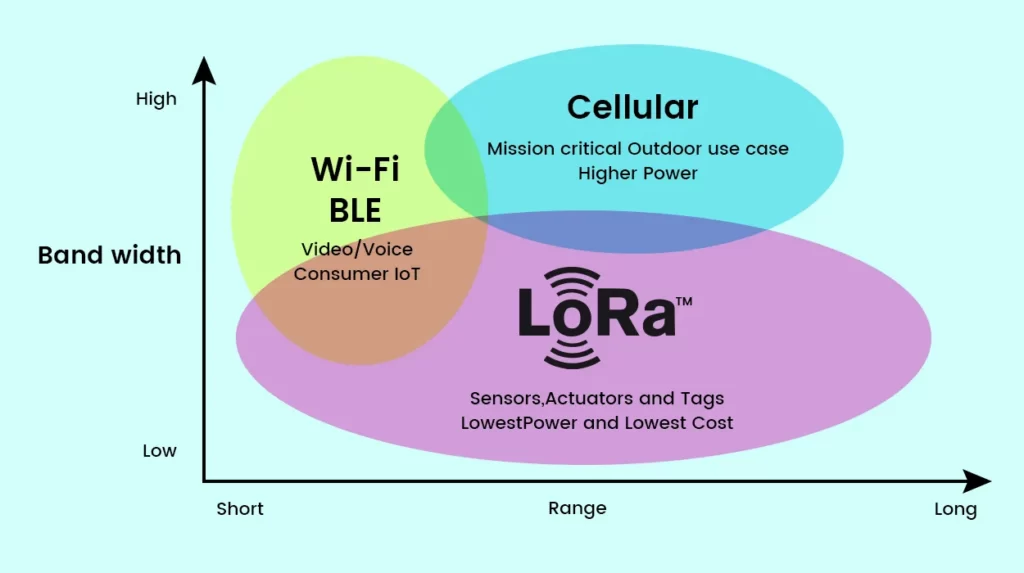
LoRa (Long Range)
LoRaWAN devices and the accessible LoRaWAN protocol allow smart operation of IoT applications that address some of the world’s most pressing issues, including energy storage, natural resource conservation, pollution protection, infrastructure reliability, disaster preparedness, and more. Semtech’s LoRa systems and the LoRaWAN protocol have a long list of applications in smart metering, smart homes, smart supply chain and logistics, smart towns, smart agriculture, and other areas.
It’s important to note that LoRa isn’t an LPWAN implementation in itself. The chip that allows modulation is known as LoRa. In any network setup, a MAC layer is needed to set up a network. The LoRa Alliance maintains the LoRaWAN MAC layer that is synonymous with LoRa chips. While the term LoRa is often used to apply to the whole protocol, this document would use a strict description of LoRa to distinguish Link Labs’ Symphony Link, which uses a proprietary MAC layer on top of a LoRa chip.

LoRaWAN
The LoRaWAN IoT Specification is a type of LoRa Technology that uses low-power wide-area networking (LPWAN) protocol. The LoRaWAN protocol uses the radio spectrum in the Medical (ISM) Industrial, and Scientific band to wirelessly link battery-operated stuff to the Internet in state, national, or global networks. The LoRaWAN protocol together with device-to-infrastructure LoRa physical layer parameters are specified in this specification, which allows for smooth interoperability between devices.
LoRaWAN Network Infrastructure
In the LoRaWAN IoT network architecture, which is implemented in a star-star topology, gateways transmit messages between end devices and a central network processor. The LoRa physical layer uses wireless to take advantage of the Long Range, enabling a single point communication between an end device and one or more gateways. Bidirectional connectivity is possible in both types, and multicast groups are supported for effective spectrum use during tasks like Firmware Over The Air (FOTA) updates or other mass delivery messages.

End Devices
To build end-devices that will bind to LoRaWAN IoT networks, computer manufacturers will depend on LoRa Alliance standards and qualification programs. They can also reach a quicker time to market by using established Reference Design offerings offered by certain vendors, based on their experience in LoRa in IoT networks, to effectively incorporate LoRaWAN networking in their design, as well as obtain best practices for computer communication and data exchange on the network.
Radio Network
LoRaWAN IoT Gateways, which can accommodate a lot of sensors and allow private and public network deployments, can be used anywhere. The gateways allow bi-directional communication and can process messages from a large number of LoRa-based sensor end-devices at the same time. Since LoRa gateways are less costly than cellular base stations, expanding the network bandwidth is as simple as installing more gateways. Gateways can accept anything from 8 to 64 channels, allowing a network to handle millions of messages every day. The efficiency of the radio network (coverage, robustness, performance, uptime, and reliability) is directly proportional to the gateways’ quality.
Central Network
The LoRaWAN IoT Network Server (LNS) may be installed onsite or hosted in cloud platforms. It directs packets obtained from several gateways to an application server after processing them. To deploy and operate a high-performance LoRaWAN IoT network, you’ll need powerful resources to track, customize, control, and troubleshoot the gateways, as well as award the desired network QoS. Some providers are providing a comprehensive range of management tools, called Operations Support System (OSS), based on cellular network expertise, to effectively orchestrate the whole network in real-time and guarantee its perfect availability for mission-critical data processing.
Application Servers
APIs may be used to merge Radio Access Network features directly into applications repositories and dashboards, making it easier to set up and manage a LoRa and IoT network. Business owners should expand application server capability with value added services like end-device access or geolocation, as well as create innovative services that produce incremental revenue sources, to make the best of radio and core network technology.
Device Classes
LoRaWAN IoT uses three classes of devices in long range communication.
Class A (mandatory for all).
Class A devices open two short receive time windows after each transmission (designated as RX1 and RX2).
The intervals from the end of the transmission to the opening of the first and second time windows can be configured, but must be the same for all devices in the given network (RECEIVE_DELAY1, RECEIVE_DELAY2). The used frequency channels and transmission rates for the RX1 and RX2 slots may differ. Recommended values are given in a separate document – “LoRaWAN Regional Parameters” available on the LoRa Alliance website.
Class A devices are the lowest power consumption, but to transfer a message from the server to the end device, you must wait for the next outgoing message from this device.
Class B (Beacon)
In addition to the receive windows defined for Class A devices, Class B devices open additional receive windows on a schedule. To synchronize the opening times of additional, receive windows, gateways emit beacons. All gateways that are part of the same network must emit beacons at the same time. The beacon contains a network identifier and a time stamp (UTC).
The use of class B ensures that when polling the endpoints, the response delay will not exceed a certain amount determined by the period of the beacons.
Class C (Continuous)
Class C devices are in receive mode almost all the time, except for the intervals when they transmit messages. Except for the RX1 time window, the terminal uses the RX2 receive parameters.
Class C can be used where it is not necessary to save energy with all its might (electricity meters) or where it is necessary to poll terminal devices at arbitrary times.
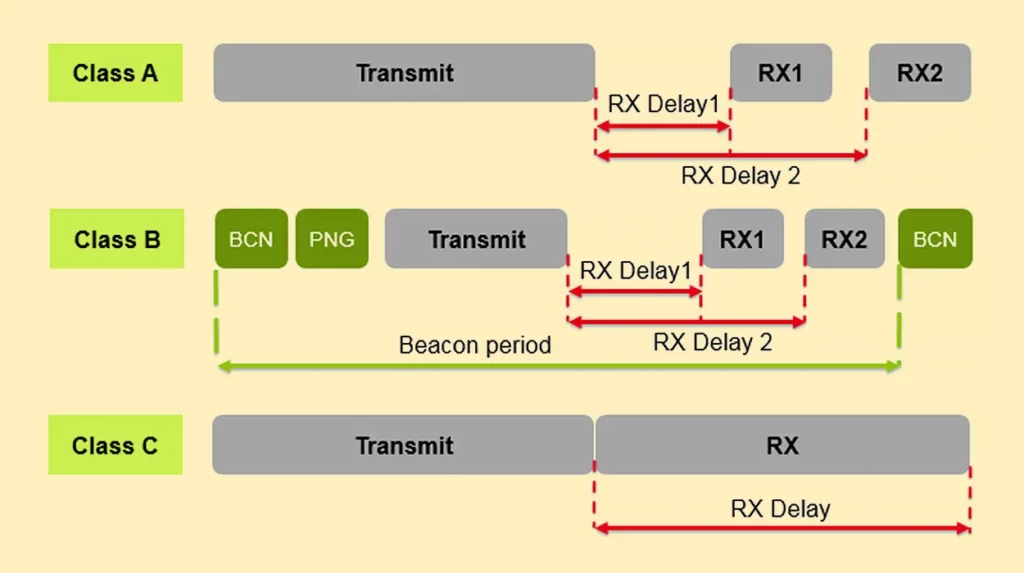
Regional Coverage
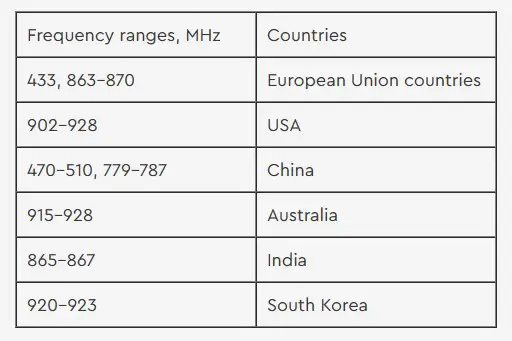
Data rates
By selecting data rates, you will create a complex tradeoff between contact range and message duration. Furthermore, spread spectrum technology ensures that connectivity with multiple DRs does not conflict with one another, resulting in a series of interactive “code” channels that boost the gateway’s throughput. The LoRaWAN network server uses an Adaptive Data Rate (ADR) scheme to monitor the DR setting and RF output capacity per each endpoint independently to optimize endpoint battery life and total network bandwidth.

Security
Authentication of Devices:
There are two verification techniques that are supported by LoRa.
- Personalized activation ABP – here, DevAddr address and encryption keys are written into the gadget early in time (device personalization))
Network and program session keys, as well as a pre-allocated 32-bit computer network address, are used to configure devices, similar to static IP address allocation.
- Over-the-Air Activation (OTAA) (requires a joint procedure, during which DevAddr address and session encryption keys are created).
OTAA allows devices to submit a communication request to a network server, which then authenticates the computer and assigns it an address as well as a token for obtaining session keys. The network and application session keys are derived during the connection procedure from the public application key previously provisioned on the device.

Parameters
The bandwidth has no bearing on the LoRa chirp rate. The chirp rate is, in truth, proportional to the bandwidth. Given that a LoRa symbol is made up of 2SF chirps that cover the whole frequency band (SF denotes the log2 spreading factor), the interaction between chirp amplitude and bandwidth has a lot of implications:
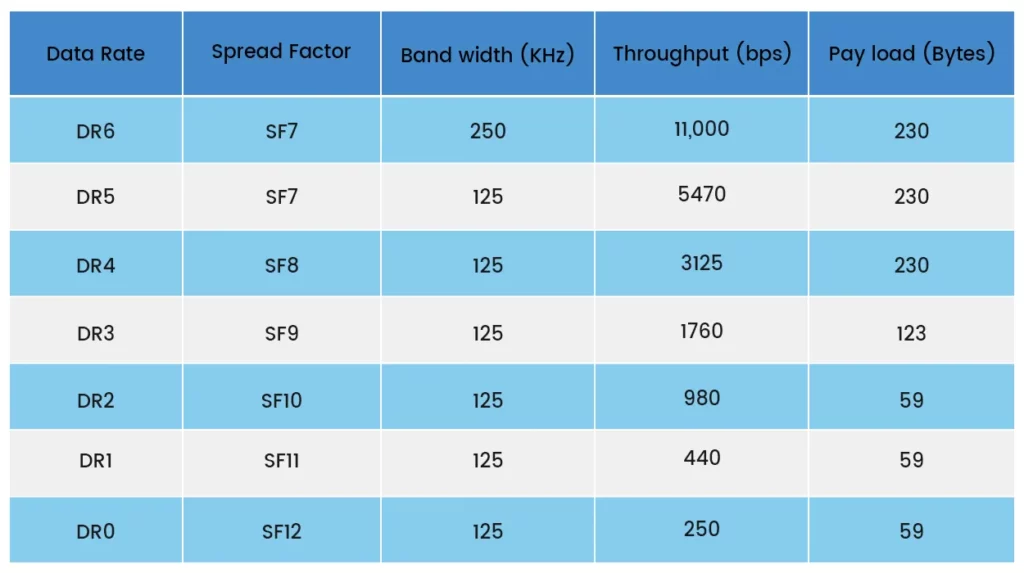
Format
To relay physical frames, LoRa employs a basic structure:
Each message starts with an up-chirp preamble that encodes a sync word by covering the entire frequency band. The term “sync” distinguishes the LoRa network from those operating in the same frequency range.
The optional header specifies the payload size, code rate, and whether or not a payload CRC is present.
The header is followed by the payload and an optional CRC.

LPWAN Technology Options
The increasing use LoRa for the Internet of Things is influencing, altering, and managing our world all around us. This technology has allowed significant advancements in the rapid exchange of reliable data, and has resulted in increased productivity for organizations ranging from small enterprises to large cities. The portion below discusses the importance of LoRa technology.

LoRa Technology Driving the Global Use of IoT
It’s as if IoT technology is maturing, and there are a variety of reasons why LoRa-based networks are increasingly becoming the preferred network for design engineers working on a variety of cutting-edge IoT applications. Of course, reliability, security, and scalability are important, but the technology’s ability to operate over distances of up to 20 kilometers while using a fraction of the power required by other platforms is also appealing. These characteristics make LoRa ideal for bidirectional data transmission across smart buildings, smart cities, and even between countries, and they will enable IoT to play an increasingly important role in virtually everyone’s lives.
Advantages of LoRaWAN
- High range of radio signal – up to 30 km in open areas and up to 8 km in the city.
- Unique penetrating ability of radio signal – provides stable communication in hard-to-reach places: wells, basements, ravines, etc.
- Ultra-low power consumption – allows the device to stay online for up to 10 years from one battery:
- 200nA in standby mode
- 11 mA in receive mode (Rx)
- 40mA transmit (Tx) (+ 14dBm)
- Bidirectional communication – provides full interaction with devices, allows not only taking readings, but also transmitting control commands.
- Remote software update – allows remote flashing of terminal devices software.
- High security of data transmission – is made due to 128-bit encryption of information in real time and key exchange (AES), using the TLS cryptographic protocol.
- The use of modern DSP technologies, as well as the optimization capabilities incorporated in the LoRaWan protocol, ensure the operation of up to 1 million devices in the network of one base station (5000 pcs per 1 sq. Km for one base station)
- Operation in the frequency ranges 433 and 868 MHz – does not require special permits to work in the network.
Disadvantages of LoRaWAN
- Relatively low bandwidth, varies depending on the used data transmission technology at the physical layer, ranging from several hundred bit / s to several tens of kbit/s.
- The delay in data transmission from the sensor to the final application, associated with the transmission time of the radio signal, can range from a few seconds to several tens of seconds.
- Lack of a single standard that defines the physical layer and media access control for wireless LPWAN networks.
- Risks of spectrum noise in the unlicensed frequency range.
- Proprietary LoRa modulation technology, patented by Semetech.
- Limiting signal strength.
LoRaWAN IoT applications
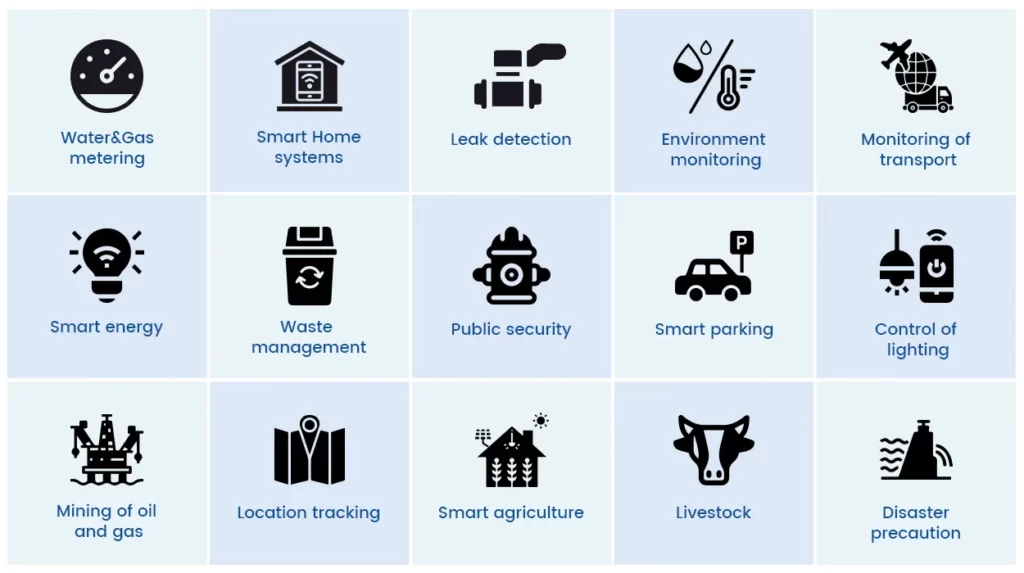
- Water&Gas metering
- Smart Home systems
- Leak detection
- Environment monitoring
- Monitoring of transport
- Smart energy
- Waste management
- Public security
- Smart parking
- Control of lighting
- Mining of oil and gas
- Locationtracking
- Smart agriculture
- Livestock
- Disaster precaution
The challenges of 5G
Because of its unmatched pace and signal strength, 5G technology is gaining popularity. It would enable connected devices to share data up to 50% faster and in far larger pieces, paving the way for a revolution in all industries.
To create a 5G network in a given location, specific networks must be built from the ground up. Despite the fact that 5G comes before 4G, it needs modern routers, fabric networks, and transmitter towers.
This infrastructure is costly and require a lot of time to install. According to the European Commission, bringing 5G to any town and city in Europe would cost €500 billion.
Furthermore, customers and suppliers have been lukewarm regarding 5G technologies so far due to its stipulated effects on humans health.
Why LoRaWAN IoT can replace 5G network for IoT
LoRa/LoRaWAN will perform much of the same activities as 5G, albeit at a slower and less expensive pace. It’s doubtful that you’ll use LoRa to submit video or audio. The speed of LoRa is between 0.3 and 27 kilobits per second, which ensures that transmitting a picture would take many hours and streaming a video will take decades.
LoRa, on the other hand, has a lot of other applications.
The system was created for industrial IoT sensors, not for consumer electronics. It’s used to send small data packets (around 240 bytes) and doesn’t have a network IP stack. As a result, LoRa will relay temperature, humidity, vibration, illumination, and other related details.
How about NB-IoT
Narrowband IoT (NB-IoT) networks are used by certain LoRa-enabled computers. NB-IoT is a low-power wide-area network (LPWAN) specification established by the same organizations that produced 4G and 5G protocols.
To put it another way, this is a cellular technology that:
- works in tandem with LoRaWAN
- is used by 4G-enabled smartphones
- Once 5G is readily accessible, it can continue to be used for some time.
- also has a higher bandwidth than LoRa as a cellular technology.
NB-IoT would not necessitate the construction of some specific infrastructure; it just necessitates the installation of applications. As a result, a network like this will quickly scale to reach millions of users. However, compared to LoRa systems, the amount of such devices is far smaller.
The biggest flaw is that NB-IoT consumes a lot of electricity, which causes battery batteries to die quickly.
NB-IoT depends on hop-by-hop encryption, which is increasingly becoming antiquated, while LoRaWAN utilizes end-to-end encryption, which is a new security protocol mechanism.
The Future of LoRaWAN
AWS LoRaWAN IoT is the future of LoRaWAN. AWS brings LoRa and IoT together to form one manageable cloud platform. Through LoRaWAN gateways, LoRaWAN devices connect with AWS IoT Core. AWS IoT rules will submit LoRaWAN system messages to other AWS resources and process them to format the results.
The service and system policies that AWS IoT Core needs to control and connect with LoRaWAN gateways and devices are managed by LoRaWAN AWS IoT Core. The destinations that define the AWS IoT rules that submit system data to other providers are also managed by LoRaWAN IoT Core.
The Development History of LoRaWAN
LoRa is a patented frequency spread spectrum. In 2008, French company Cycleo patented the technology, and in 2012 Semtech bought it. From that moment on, LoRaWAN took off. Semtech managed to capture the attention of IBM and Cisco in the new technology, which later entered the LoRa Alliance.
LoRaWAN (Long Range wide-area networks) is deployed in the license-free frequency spectrum.
Devices in the LoRaWAN network asynchronously transmit data to be sent to the gateway. Several gateways that receive this information then send data packets to a centralized server on the network, and from there to the application servers.
The LoRa Alliance is the one that controls the protocol in the whole world. The alliance brings together over 500 hardware and software companies and LoRaWAN operators.
LoRaWAN communication services are provided by 42 operators in more than 250 cities around the world.
How LoRaWAN Works
The “LoRa IoT” (a channel connecting end devices to the operator’s access point), built using LoRaWAN technology, can be characterized by three features: “far, autonomous over a long period of time, and economical”.
LoRaWAN networks have a high deployment speed (from two days) and simple commissioning. Star topology creates a large coverage radius for each base station and eliminates intermediate equipment.
Thanks to the ADR (Auto-Tuning Data Rate) mode, the end devices are only active during data transfer. This, coupled with the low power of the transmitter itself, allows the device to function autonomously for up to 10 years from one battery, as well as increase the number of devices communicating with one base station and scale the network.
The low cost of base stations and end nodes allows some solutions to be implemented up to 10 times cheaper compared to low-current systems such as ZigBee or GSM / GPRS.
LoRa is an open standard, and this avoids monopoly and dependence on specific equipment manufacturers. Another advantage of openness is the unification of developers and manufacturers using this technology in an alliance, which allows it to develop and promote it faster and more efficiently.
Because of these characteristics, LoRaWAN is ideal for systems with high requirements for communication stability over long distances and low power consumption, allowing end devices to work autonomously and without recharging for a long time. Thus, it is possible to assemble various types of devices into a single system – street lights, metering devices for the consumption of housing and communal services (electricity, water, gas, heat), a fleet of vehicles (control of movement, fuel consumption), security devices (access control), etc. , as well as create fundamentally new solutions in the field of communication services, monitoring, telematics, telemechanics, dispatching, ASKUE, APCS, smart home and smart city systems, etc.
LoRaWAN Deployment
LoRaWAN is typically distributed in unlicensed spectrum, allowing everyone to build a LoRaWAN-based IoT/LPWAN network. Three implementation models are possible as a result of this:
Operator-based: Under this conventional model, an operator invests in building a national network and only provides connectivity services to its subscribers.
Enterprise based: Since LoRaWAN operates in unlicensed spectrum and gateways are relatively inexpensive and simple to install, this model allows commercial customers to set up their own private network.
Hybrid model: Due to its open design, LoRaWAN makes for the most intriguing hybrid paradigm, which is not feasible or difficult in other rival LPWA or Cellular IoT technologies (due to licensed spectrum). Inside 3GPP, there are projects like CBRS, however they are still in the works and far from being ready for large-scale IoT deployments. This model allows a public-private collaboration to share network expenses and sales while still densifying the network where apps and services are most prevalent. Since several gateways will accept LoRaWAN messages, and the network server eliminates redundancy, this model is possible. In situations where the network is operated by several operators/enterprises, the LoRa Alliance has already accepted a roaming architecture that allows operators to share the network. This model decreases operator spending while still providing a transformative business model for deploying IoT capability where it is most required. We illustrate how LoRaWAN potential scales significantly with gateway density in the final section of the paper.










